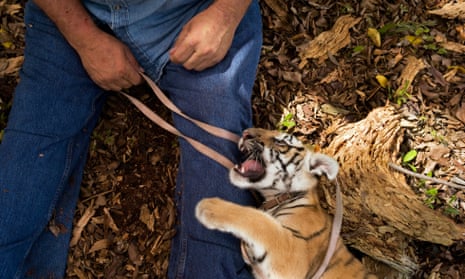According to estimates, the population of tigers in people’s back gardens in the US outnumbers those in the wild. Seven thousand of the big cats live in US captivity, whereas, despite increases, there are as few as 3,890 wild tigers worldwide. Most of the captive animals are kept in unregulated conditions, as the BBC reported last week. Only 6% are housed in zoos or facilities approved by the US Association of Zoos and Aquariums. The rest live in private breeding facilities, back yards, even urban apartments. In some states, it is easier to buy a tiger than to adopt a rescue dog.
Leigh Henry, a species policy expert at the World Wildlife Fund, says the situation threatens the work that has been done to conserve wild populations in Asia. “A patchwork of regulations governs these tigers, meaning no agency can say how many there are, when they are born, when they die and what happens to their valuable parts when they do. Illegal trade in tiger parts remains the primary threat to tigers in the wild, and the last thing we want is parts from captive tigers helping sustain or even fuel this black market.”
This is bad for humans, too. In 2011, an owner of exotic pets in Zanesville, Ohio, released his menagerie into the community; 18 tigers and other animals were shot to protect people. In 2001, Texas was forced to pass a law demanding owners register their animals after a pet tiger ripped off a young boy’s arm. “Since 1990, there have been hundreds of dangerous incidents involving big cats in the US. Four children lost their lives and dozens of others lost limbs or suffered other often traumatic injuries. Nineteen adults have been killed and scores have been mauled,” says Debbie Leahy, the manager for captive wildlife protection at the Humane Society of the United States. “Many captive big cats are kept in inhumane conditions, pose a threat to the community, create a burden for law enforcement agencies and sanctuaries, and compromise conservation efforts.”
The keeping of “charismatic megafaunae” as status symbols sits worryingly close to the mentality of killing wild animals for “sport”. The distinction between the wild and the tamed has been blurred. Most of us see wild animals only in TV documentaries, so they become commodities or experiences.
A tiger in your back garden is far removed from William Blake’s unknowable and majestic creature burning bright. But even Blake wrote at a time when the Exeter Exchange on the Strand in London displayed tigers, lions and elephants in a first-floor “department store”, visited by Lord Byron and Jane Austen.
As we reduce and affect their natural habitats, will we be left with big cats as flea-bitten, oversized but potentially deadly kittens?

Comments (…)
Sign in or create your Guardian account to join the discussion